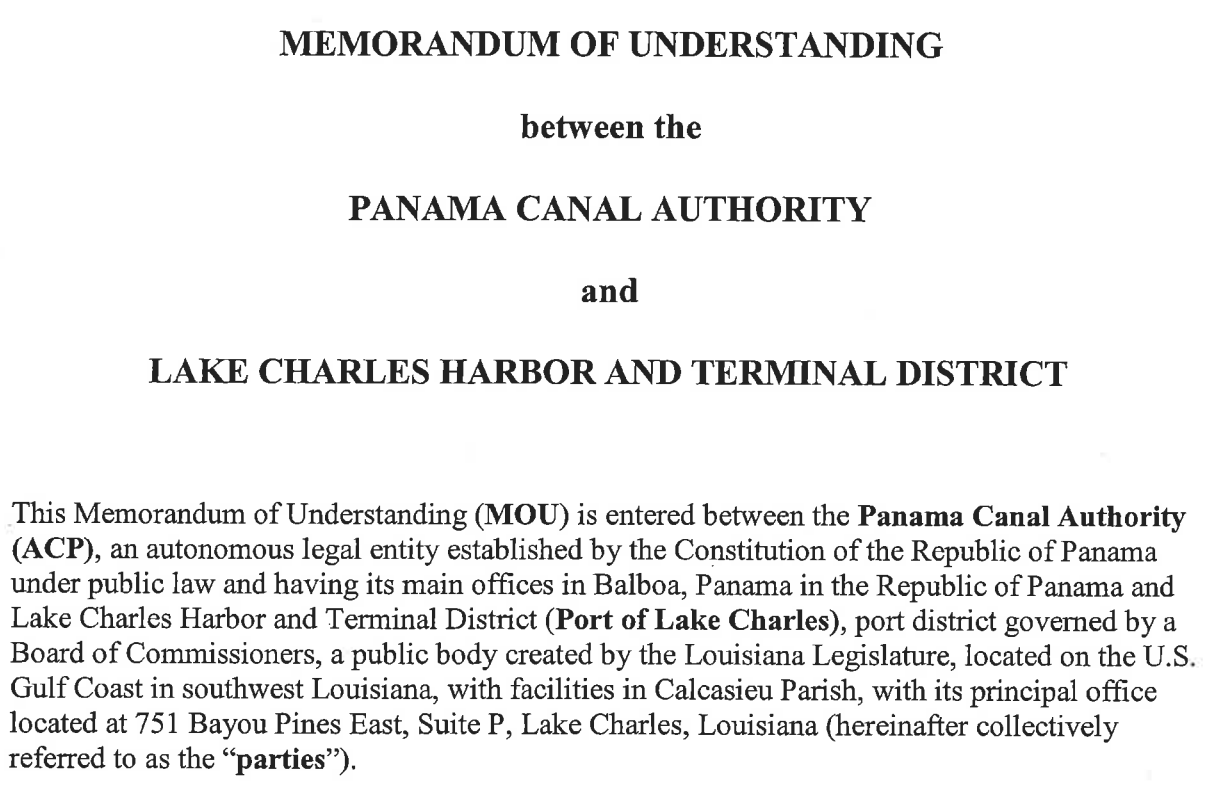- January 4, 2016
- in Green Tips
- by marcos
- 639
- 0

Cross-Posted from
Image Credit: Port of Lake Charles
The records offer an inside glimpse of how — as the U.S. Federal Energy Regulatory Commission (FERC) and U.S. Department of Energy (DOE) weigh environmental and energy policy concerns before handing out LNG export permits — other federal agencies have proceeded as if the permits are a fait accompli.
They also further raise the specter that, as some have highlighted, FERC and DOE merely serve as rubber-stamp regulatory agencies in service to powerful industrial interests. Further, they demonstrate how pivotal the proposed and nearly operational Panama Canal expansion project is for the LNG shipping industry moving forward.
While the LNG export company-heavy Port of Lake Charles signed an MOU with the Panama Canal Authority on January 6, 2015, the emails date back to February 13, 2014. The MOU mentions LNG a few times throughout the text.
Image Credit: Port of Lake Charles
On that date, Jean Collins, export assistance specialist with the U.S. Department of Trade working out of New Orleans, Louisiana, sent an email to Dan Loughney, Director of Marketing and Trade Development for the Port of Lake Charles, inviting him to an October 2014 trade mission in Panama hosted by the Louisiana District Export Council.
The Louisiana District Export Council is a sub-unit of the broader U.S. Commercial Service and U.S. Export Assistance Center (USEAC).
“The goal of the mission is to help participating Louisiana companies and organizations foster new business and partnerships in Panama,” explained Collins’ email. “Working in conjunction with the U.S. Commercial Service offices in New Orleans and Panama, the mission organizers will further develop relationships between C-100 member organizations.”
C-100, shorthand for Committee of 100 Louisiana, describes itself as “Louisiana’s Business Roundtable” and as a coalition of “the top CEOs of leading private and public companies in Louisiana and University presidents of Louisiana’s institutions of higher learning.”
Representatives from ExxonMobil, Shell, Cheniere and Louisiana Oil and Gas Association all serve as C-100 members.
An April 3, 2014 email sent from the CEO of the C-100 — Michael Olivier, former Secretary of Economic Development for Louisiana’s former Democratic Party Governor Kathleen Blanco — explains that C-100 sent an “advance team” to Panama and “found a great interest from the Panama Canal [Authority] to enter into an MOU with the Port of Lake Charles” due to its proximity to Cheniere’s U.S. Gulf coast-based assets.
According to a news report published a couple days before the trade mission, one of the attendees was Greg Michaels, CEO and Chairman of the proposed SCT&E LNG export terminal.
“Michaels has a keen interest in the passage of LNG vessels through the canal and will hold meetings and discussions with Panamanian officials regarding such,” explains the article published by the business publication LNG Industry. “SCT&E LNG plans to ship LNG through the canal via large ocean going LNG vessels, thus making this Panama Trade Mission an important and timely event.“
LNG Industry also explained that the trade mission in Panama would help open doors to investors for Michaels.
“While visiting in Panama’s favorable business climate, Michaels will meet with prospective investors interested in the US$ 9.2 billion liquefaction project,” LNG Industry wrote. “His itinerary will also include meetings regarding potential electrical generation projects and LNG terminals in the region.”
SCT&E LNG had only sent in an LNG export application to the DOE five months prior to the trade mission for consideration and has yet to file an application with FERC.
Michael Olivier contacted Dan Loughney in an April 10 email to tell him that then-Panama Ambassador to the U.S., Mario Jaramillo, would soon visit Louisiana to help develop the agenda for the planned October trade mission to Panama. Jaramillo formerly served on the Board of Directors of Gas Natural Fenosa, a Spanish corporation that produces and distributes gas and electricity in Panama.
Panama’s current Ambassador to the U.S., Emanuel Gonzalez-Revilla, also formerly worked for the oil and gas industry as chairman for Melones Oil Terminal, Inc., “a full service fuel storage facility in the Pacific entrance of the Panama Canal; as well as Vice Chairman of Trader Tankers, Ltd., a premier barge and bunkering operation providing fuel to ships crossing The Panama Canal,” according to the Embassy of Panama in the U.S. website.
In the aftermath of the trade mission, C-100 published a debriefing of sorts, provided to DeSmog by Olivier. That debriefing explains that along with SCT&E LNG, representatives from the Australia-headquartered and Lake Charles-based Magnolia LNG export facility proposal also attended the trade mission, as did a representative from Technology Associates, Inc, a company that manufactures LNG tanker fueling technology.
Of course, there is always the question whether this is standard operating procedure and FERC and DOE just exist to provide a rubber stamp.
Both agencies denied a request for comment for this story, as did spokespeople for the Department of Trade, U.S. Export Assistance Center and U.S. Commercial Service.
“There is no question that the FERC is a rubber-stamp for oil and gas,” said Margaret Flowers, an activist with the Beyond Extreme Energy coalition and U.S. Senate candidate for the Green Party in Maryland. “The FERC is fully funded by the permits it grants to industry. This is an incentive to permit projects, especially those such as LNG terminals, that lead to more permits for pipelines and compressor stations.”
Flowers thinks FERC needs a totally revamped vision going forward.
“The FERC needs to be totally remade so that it has a mission that takes critical issues such as the health and safety of communities and the climate crisis into account,” she explained.
— This feed and its contents are the property of The Huffington Post, and use is subject to our terms. It may be used for personal consumption, but may not be distributed on a website.


